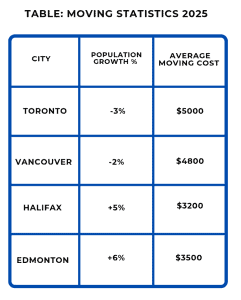
As we navigate the ever-evolving landscape of 2025, relocation trends across Canada are capturing the attention of home buyers, real estate investors, and urban planners alike. The shifting patterns of moving statistics are largely influenced by factors such as housing availability and fluctuating housing costs, which have become pivotal in shaping the Canada real estate market. With a keen eye on housing market predictions, individuals and families contemplating a move are increasingly weighing the cost of moving in Canada against potential benefits. In this blog post, we delve into the 2025 moving trends, examining how these elements interplay to create a dynamic environment for relocation in Canada. Whether you’re a prospective home buyer or a housing market analyst, this exploration will offer valuable insights into the future of relocation across Canada.
Analyzing 2025 Moving Trends
As we delve into the moving trends of 2025, it’s clear that relocation patterns in Canada are evolving. This section explores current trends, insights from moving statistics, and the pivotal role of moving companies in facilitating these transitions.
Current Relocation Trends Canada
Relocation trends in Canada are increasingly being driven by urbanization and remote work flexibility. Recent studies show a shift towards smaller cities and suburban areas, as individuals and families seek a balance between urban conveniences and affordable living. The move away from major metropolitan areas is often influenced by lifestyle preferences, as well as economic factors like housing costs and job opportunities.
Current trends also reflect a growing interest in regions with robust infrastructure and community amenities. This shift is reshaping the housing demand landscape, impacting everything from residential developments to transportation planning. As more people consider relocating, understanding these trends becomes crucial for both buyers and investors.
- Increasing demand for suburban living
- Rise in telecommuting influencing relocation decisions
- Shift towards environmentally sustainable communities
These trends are setting the stage for a dynamic housing environment in 2025.
Moving Statistics 2025 Insights
The moving statistics of 2025 highlight a significant increase in domestic relocations. According to recent data, about 15% more Canadians are moving than in previous years, driven by economic recovery and lifestyle changes. Urban areas like Toronto and Vancouver are seeing a decline in new residents, while cities like Halifax and Edmonton are witnessing an influx.

These statistics illustrate the varied landscape of Canadian relocation in 2025. Analyzing these numbers helps us understand the broader economic and social implications of these moves.
The Role of Moving Companies Canada
In 2025, moving companies play an essential role in facilitating smooth transitions. As the demand for professional moving services grows, companies are expanding their offerings to include full-service packages, which cover everything from packing to unpacking.
- Consultation: Initial assessment of moving needs and costs.
- Packing Services: Professional packing to ensure safe transport.
- Transportation: Safe and timely delivery of belongings.
- Unpacking and Setup: Assistance with settling into the new home.
Moving companies are responding to the need for reliable services by investing in technology and customer service improvements. This evolution is highlighted in insights shared by emerging trends in real estate.
Canada Housing Market Predictions
The Canadian housing market in 2025 is shaped by several factors, including availability and cost trends. This section provides an overview of what to expect in terms of housing supply and economic forecasts.
Canada Housing Availability Overview
Canada’s housing availability in 2025 is characterized by a tight supply in major cities, with a growing market in smaller urban centers. The housing market outlook suggests that while supply constraints remain, innovative housing solutions are emerging.
- Emphasis on multi-family dwellings
- Increase in affordable housing projects
- Development of smart housing technologies
These developments are designed to address the ongoing challenges of housing availability, particularly in high-demand areas, and aim to enhance the quality of life for residents.
Housing Cost Trends in Canada
Housing cost trends in Canada for 2025 indicate a stabilization in prices, after years of significant increases. According to housing trends in 2025, the market is showing signs of leveling out, particularly in regions that experienced rapid growth.
- Average home prices in major cities have plateaued
- Smaller cities are seeing moderate price increases
- Interest rates remain a key factor in affordability.
These trends provide a cautious optimism for potential buyers, as the market adjusts to new economic realities.
Planning Your Move in 2025
For those considering buying a home in Canada in 2025, expert insights can be invaluable. Here are some recommendations for navigating the market:
- Research local markets: Understand regional trends and pricing.
- Consider long-term growth: Look for areas with potential for appreciation.
- Secure financing early: Lock in interest rates to mitigate future increases.
- Consult professionals: Work with real estate agents and financial advisors.
These tips are designed to empower home buyers, ensuring they make informed and confident decisions in an ever-changing market.
.

